Sweet Corn IPM Newsletter No. 4 – July 23, 2021
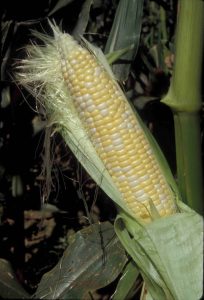
Sweet Corn IPM Newsletter No. 4 – July 23, 2021
Click on photos to enlarge.
PEST PRESSURE INCREASING FOR SILKING CORN
Corn Earworm, Fall Armyworm & European Corn Borer Numbers Higher
SITUATION
Early corn harvest is underway in Southern Maine. Recent rains have made access to some fields difficult as we experience a second mud season for the year. Our traps caught all of the major corn pests this week, exceeding the spray threshold for silking corn in several locations. Western bean cutworm counts were also higher, adding another threat for the season.
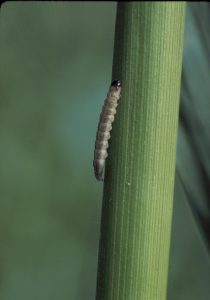
European corn borer:
Larval feeding injury was not over the 15% control threshold in any locations this week although low levels of feeding activity was observed in most fields. European corn borer moth trap counts were over the spray threshold of 5/week in: Auburn, Monmouth, Sabattus, Wells, and one Dayton site. The Auburn and Sabattus sites are also under a spray schedule for corn earworm, which should provide control of corn borer.
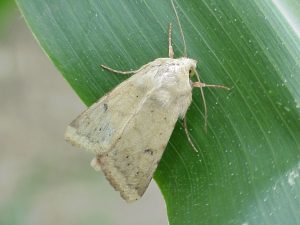
Corn earworm:
Moth captures in pheromone traps were spotty around the state this week, but there is an upward trend in their populations. Silking fields in one Well site are on a 6-day spray interval to protect against corn earworm. Auburn and Farmington sites are on a 5-day spray schedule, and New Gloucester has a 4 day spray schedule recommended. Other sites had very low or no moth counts this week, but expect that situation to change soon, and continue to monitor silking corn.
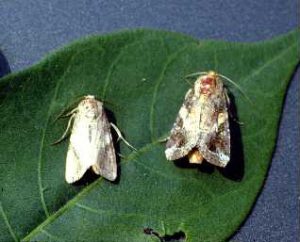
Fall armyworm:
We caught fall armyworm moths in most locations this week. Fall armyworm larvae threaten corn by feeding voraciously on foliage, tassels and chewing into the ears. Moths may also lay eggs on silking corn, allowing the larvae to move into the ears through the silk channels while leaving no visible feeding injury on the plants. Counts were over the threshold of 3 moths per week in silking corn in Cape Elizabeth, Garland, and New Gloucester. The New Gloucester site is also on a spray schedule for corn earworm, which should provide protection against fall armyworm. We have not yet found any feeding damage in the field, but expect it will become visible soon.

Western Bean Cutworm:
Moth counts were higher this week in most locations. This “new” pest behaves similarly to fall armyworm on sweet corn, feeding on foliage and entering the ears. Sprays are recommended when feeding levels reach 8% in a field, or when moths are active in silking fields.

Squash vine borer:
We are catching moths in pheromone traps this week and damage is being reported in some southern fields. Be on the lookout for squash vine borer feeding at the base of the plants and/or wilting vines and apply appropriate control if damage is found.
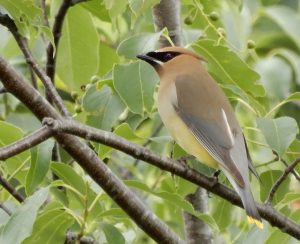
Birds are already causing injury to corn ears in some fields. Repelling birds can be a big challenge for growers. Recent research has found that scare eye balloons and air dancers can reduce injury significantly if placed correctly. De-tasseling immediately following pollination was very effective in deterring birds, but is labor intensive. You can find a summary of the research through this link
Sincerely,
David T. Handley
Vegetable & Small Fruit Specialist
Highmoor Farm Pest Management Unit
P.O. Box 179 17 Godfrey Drive
52 U.S. Route 202 Orono, ME 04473
Monmouth, ME 04259
207.933.2100 1.800.287.0279
| Location | CEW
Moths |
ECB
Moths |
FAW
Moths |
%Feeding
Damage |
Recommendations / Comments |
|---|---|---|---|---|---|
| Auburn | 4 | 14 | 1 | 5% | 5-day spray interval for silking corn |
| Biddeford | 0 | 0 | 0 | 4% | No spray recommended |
| Bowdoinham | 0 | 1 | 0 | 3% | No spray recommended |
| Cape Elizabeth | 0 | 0 | 3 | 3% | One spray for FAW on silking corn |
| Dayton I | 0 | 3 | 0 | 0% | No spray recommended |
| Dayton II | 0 | 8 | 1 | 2% | One spray for ECB on silking corn |
| Farmington | 4 | 1 | 1 | 2% | 5-day spray interval for silking corn |
| Garland | 1 | 1 | 10 | 0% | One spray for FAW on silking corn |
| Lewiston | 0 | 0 | 0 | 0% | No spray recommended |
| Monmouth | 0 | 32 | 0 | 8% | One spray for ECB on silking corn |
| New Gloucester | 15 | 1 | 28 | 3% | 4-day spray interval for silking corn |
| Oxford | 0 | 0 | 0 | 2% | No spray recommended |
| Palmyra | 0 | 0 | 0 | 0% | No spray recommended |
| Sabattus | 1 | 16 | 2 | 7% | One spray for ECB on silking corn |
| Wayne | 0 | 1 | 0 | 5% | No spray recommended |
| Wells I | 0 | 5 | 0 | 0% | One spray for ECB on silking corn |
| Wells II | 2 | 3 | 2 | 0% | 6-day spray interval for silking corn |
*Traps just set up-no data yet
CEW: Corn earworm (Only fresh silking corn should be sprayed for this insect.)
ECB: European corn borer
FAW: Fall armyworm
| Moths caught per week | Moths caught per night | Spray interval |
|---|---|---|
| 0.0 to 1.4 | 0.0 to 0.2 | No spray |
| 1.5 to 3.5 | 0.3 to 0.5 | Spray every 6 days |
| 3.6 to 7.0 | 0.6 to 1.0 | Spray every 5 days |
| 7.1 to 91 | 1.1 to 13.0 | Spray every 4 days |
| More than 91 | More than 13 | Spray every 3 days |
Thresholds apply only to corn with exposed fresh silk. Lengthen spray intervals by one day if maximum daily temperature is less than 80°F.
European Corn Borer Thresholds
Whorl stage: 30% or more of plants scouted show injury.
Pre-tassel-silk: 15% or more of plants scouted show injury.
Silk: 5 or more moths caught in pheromone traps in one week.
IPM Web Pages:
Where brand names or company names are used, it is for the reader’s information. No endorsement is implied nor is any discrimination intended against other products with similar ingredients. Always consult product labels for rates, application instructions and safety precautions. Users of these products assume all associated risks.
The University of Maine is an equal opportunity/affirmative action institution.
